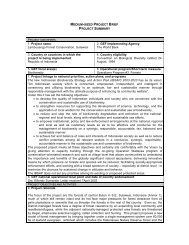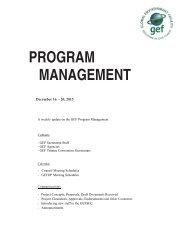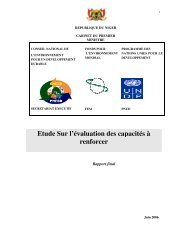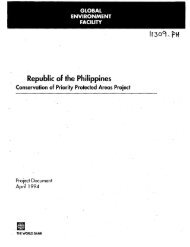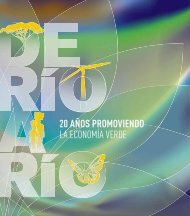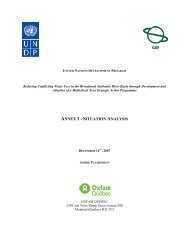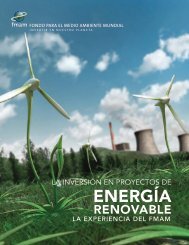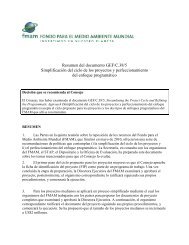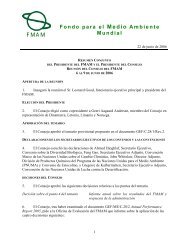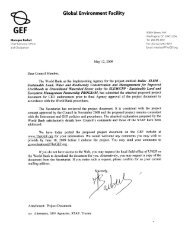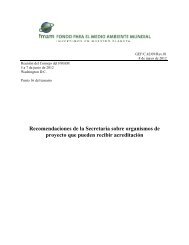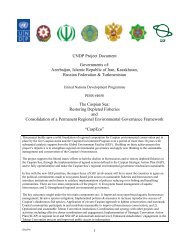English - Global Environment Facility
English - Global Environment Facility
English - Global Environment Facility
Create successful ePaper yourself
Turn your PDF publications into a flip-book with our unique Google optimized e-Paper software.
A. Background<br />
- 2 -<br />
I. DESCRIPTION AND RESULTS MONITORING<br />
1. The Role of Ecotourism in Panama´s Protected Area System<br />
1.1 With a territory extending 75,517 km 2 , Panama is considered one of the countries<br />
with the highest biodiversity of the Central American region, performing an<br />
important function of natural connectivity between North America and South<br />
America. Over 1,300 endemic species have been identified among plants,<br />
amphibians, reptiles, birds, mammals and fresh water fish 1 . In recognition of this<br />
significant biodiversity, the Government of Panama has established the National<br />
System of Protected Areas (SINAP: Sistema Nacional de Áreas Protegidas). The<br />
system’s objective is to protect and maintain biological diversity in terrestrial,<br />
coastal, marine and other ecosystems, and to promote recreation, education, and<br />
natural resources research. Under the authority of the Panama National<br />
<strong>Environment</strong> Authority (ANAM), the SINAP has been expanded and<br />
strengthened over the last decade and many of the existing protected areas have<br />
achieved international recognition as World Heritage Sites, Ramsar sites 2 and<br />
Biosphere Reserves. At present, the system includes 89 protected areas (PAs)<br />
covering a total area of approximately 2,922,648.72 ha, which represents 34% of<br />
the national territory. Only 19 (21%) of the PAs in the system currently have<br />
their management plans and most are still in need of developing and<br />
implementing strategic planning, operating and financing plans and monitoring<br />
and supervision plans. In most of these Protected Area (PA)s, ANAM is<br />
implementing an innovative monitoring program of management effectiveness<br />
(“Programa de Monitoreo de la Efectividad del Manejo de las Areas Protegidas<br />
de Panama – PMEMAP”) which is applied on a annual basis in each PA, with the<br />
participation of local communities and stakeholders.<br />
1.2 This significant biodiversity and a unique ethnic-cultural base are two of the<br />
country’s greatest assets that have helped propel the tourism sector to the<br />
forefront of the country`s competitiveness efforts. At present, tourism is a driving<br />
force in Panama´s economy, with an average 10% annual increase registered from<br />
2004-2008. A total of 1,573,070 persons visited Panama in 2008 of which 80%<br />
were tourists 3 . Past inventories (IPAT/OEA, 1993) have concluded that about<br />
72% of the country’s attractions were within the SINAP at that time. Yet only<br />
about 3% of total visitors reportedly visited a protected area in Panama between<br />
2004-2009 (compared to 54% in Costa Rica, 2006), resulting in significant<br />
financial challenges for the SINAP as most of the resources for management<br />
come from entrance fees and these raise no more than $300,000/year, according to<br />
ANAM statistics and a diagnostic conducted during project preparation.<br />
1 ANAM 2007. Estado del Conocimiento y Conservación de la Biodiversidad y de las Especies de Vertebrados<br />
de Panamá.<br />
2 Sites recognized under the Ramsar Convention (The Convention on Wetlands of International Importance)<br />
3 Informe Económico 2008 del Ministerio de Economía y Finanzas de Panamá.



